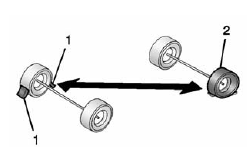Chevrolet Captiva Owners Manual: Tire Chains, If a Tire Goes Flat
Tire Chains
Warning
Do not use tire chains. There is not enough clearance. Tire chains used on a vehicle without the proper amount of clearance can cause damage to the brakes, suspension, or other vehicle parts. The area damaged by the tire chains could cause loss of control and a crash.
Use another type of traction device only if its manufacturer recommends it for the vehicle's tire size combination and road conditions. Follow that manufacturer's instructions. To avoid vehicle damage, drive slow and readjust or remove the traction device if it contacts the vehicle. Do not spin the wheels.
If traction devices are used, install them on the front tires.
If a Tire Goes Flat
It is unusual for a tire to blow out while driving, especially if the tires are maintained properly. See Tires on page 10-37. If air goes out of a tire, it is much more likely to leak out slowly. But if there ever is a blowout, here are a few tips about what to expect and what to do: If a front tire fails, the flat tire creates a drag that pulls the vehicle toward that side. Take your foot off the accelerator pedal and grip the steering wheel firmly. Steer to maintain lane position, and then gently brake to a stop, well off the road, if possible.
A rear blowout, particularly on a curve, acts much like a skid and may require the same correction as used in a skid. Stop pressing the accelerator pedal and steer to straighten the vehicle. It may be very bumpy and noisy. Gently brake to a stop, well off the road, if possible.
Warning
Driving on a flat tire will cause permanent damage to the tire.
Re-inflating a tire after it has been driven on while severely underinflated or flat may cause a blowout and a serious crash.
Never attempt to re-inflate a tire that has been driven on while severely underinflated or flat.
Have your dealer or an authorized tire service center repair or replace the flat tire as soon as possible.
Warning
Lifting a vehicle and getting under it to do maintenance or repairs is dangerous without the appropriate safety equipment and training. If a jack is provided with the vehicle, it is designed only for changing a flat tire. If it is used for anything else, you or others could be badly injured or killed if the vehicle slips off the jack. If a jack is provided with the vehicle, only use it for changing a flat tire.
If a tire goes flat, avoid further tire and wheel damage by driving slowly to a level place, well off the road, if possible. Turn on the hazard warning flashers. See Hazard Warning Flashers on page 6-3.
Warning
Changing a tire can be dangerous. The vehicle can slip off the jack and roll over or fall causing injury or death. Find a level place to change the tire. To help prevent the vehicle from moving:
- Set the parking brake firmly.
- Put an automatic transmission in P (Park) or a manual transmission in 1 (First) or R (Reverse).
- Turn off the engine and do not restart while the vehicle is raised.
- Do not allow passengers to remain in the vehicle.
- Place wheel blocks on both sides of the tire at the opposite corner of the tire being changed.
When the vehicle has a flat tire (2), use the following example as a guide to assist in the placement of the wheel blocks (1).

- Wheel Block
- Flat Tire
The following information explains how to repair or change a tire.
 Wheel Alignment and Tire Balance, Wheel Replacement
Wheel Alignment and Tire Balance, Wheel Replacement
Wheel Alignment and Tire Balance
The tires and wheels were aligned
and balanced at the factory to
provide the longest tire life and best
overall performance. Adjustments to
wheel alignment and ti ...
 Tire Changing
Tire Changing
Removing the Spare Tire and Tools
To access the spare tire:
Open the liftgate.
Push the levers on the load floor.
Lift the load floor and hang the
hook to the tailgate opening.
...
More about:
Chevrolet Captiva Service & Repair Manual > Brakes: Brake Fluid Level Warning Indicator Switch R&R
Ensure the retaining tabs on the
brake fluid level indicator switch are fully engaged in the master cylinder
reservoir.
1.
Remove the underhood electrical center.
2.
Disconnect the brake fluid level indicator
switch ...
Chevrolet Captiva Owners Manual
- Introduction
- In Brief
- Keys, Doors, and Windows
- Seats and Restraints
- Storage
- Instruments and Controls
- Lighting
- Infotainment System
- Climate Controls
- Driving and Operating
- Vehicle Care
- Service and Maintenance
- Technical Data
- Customer Information
- OnStar
